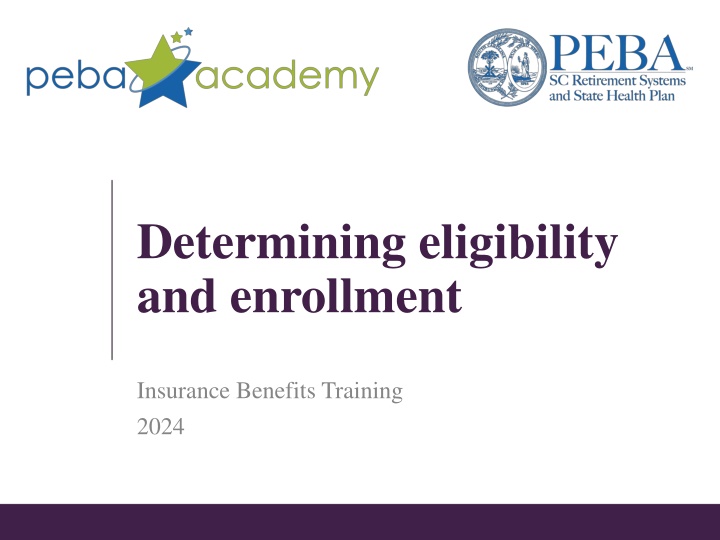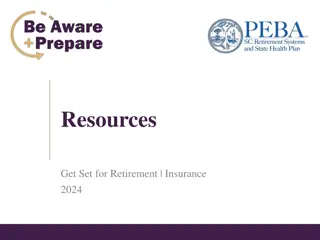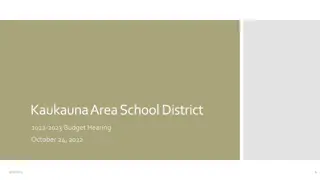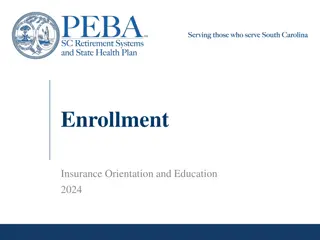Insurance Benefits Enrollment Guidelines 2024
This information provides guidance on determining eligibility and enrolling in insurance benefits, emphasizing the Affordable Care Act requirements for offering coverage to eligible employees. It covers employee types, enrollment timelines, and specifics for new full-time employees. Key resources and important details for enrollment within PEBA insurance benefits are highlighted.
Download Presentation

Please find below an Image/Link to download the presentation.
The content on the website is provided AS IS for your information and personal use only. It may not be sold, licensed, or shared on other websites without obtaining consent from the author.If you encounter any issues during the download, it is possible that the publisher has removed the file from their server.
You are allowed to download the files provided on this website for personal or commercial use, subject to the condition that they are used lawfully. All files are the property of their respective owners.
The content on the website is provided AS IS for your information and personal use only. It may not be sold, licensed, or shared on other websites without obtaining consent from the author.
E N D
Presentation Transcript
Determining eligibility and enrollment Insurance Benefits Training 2024
Important information This overview is not meant to serve as a comprehensive description of the insurance benefits offered by PEBA. More information can be found in the following: Benefits Administrator Manual; and Insurance Benefits Guide. The plan of benefits documents, certificates of coverage and benefits contracts contain complete descriptions of the insurance benefits offered by or through PEBA. Their terms and conditions govern all of these benefits. 2
Affordable Care Act (ACA) As a participating employer in PEBA insurance benefits, you must offer coverage to all employees eligible to participate in the insurance benefits. Resources at peba.sc.gov/aca. ACA glossary. Affordable Care Act FAQs. Reporting requirements and quick reference guides. 3
Types of employees New full-time employees (permanent or non-permanent). Newly hired employee who is determined by employer, as of the date of hire, to be full-time and eligible for benefits. New variable-hour, part-time or seasonal employees. Newly hired employee who is not expected to be credited an average of 30 hours per week as of the date of hire. Employer cannot reasonably determine eligibility for benefits as of the date of hire. Ongoing employees. Any employee who has worked with an employer for an entire Standard Measurement Period. 4
When to enroll New full-time employees and retirees. Within 31 days of date of hire or retirement. New variable-hour, part-time and seasonal. During Initial Administrative Period. All eligible employees. During the Administrative Period or open enrollment period. Enrollment and changes are effective the following January 1. Within 31 days of a special eligibility situation. 5
New full-time employees Are expected to work 30 hours or more per week as of their date of hire. Enroll within 31 days of date of hire. No waiting period. No Initial Measurement Period. Employees should be offered benefits at the time of hire. 6
New full-time employees If hired on the first of the month, coverage begins on that day. If hired on the first working day of the month, but not the first day of the month, employee may choose the first of that month or the first of the following month. If hired on any day other than the first or the first working day of the month, coverage begins the first of the month after the date of hire.1 1There is an exception for transfer employees. 7
New variable-hour, part-time or seasonal employees Variable-hour: Employer does not know if employee will average 30 or more hours per week. Part-time: Employer does not expect employee to average 30 hours per week. Seasonal: Position is customarily less than six months and begins around the same time each year. Employees must average 30 hours during first 12 months of employment before becoming eligible for insurance coverage. 8
New variable-hour, part-time or seasonal employees Initial Measurement Period: Begins the first of the month after the date of hire and ends 12 months later. Measure the employee s hours over the Initial Measurement Period to determine future eligibility for benefits. Initial Administrative Period: Begins the day after the Initial Measurement Period ends and ends the last day of the same month. Use this time to review the employee s hours over the Initial Measurement Period. If the employee averages 30 hours, they are eligible for coverage. Offer benefits to the employee effective the first of the following month. Initial Stability Period: Begins the day after the Initial Administrative Period ends and lasts for 12 months. Period that an employee cannot lose eligibility for benefits regardless of the number of hours worked. 9
Example: date of hire is June 6, 2023 Initial Measurement Period (monitor hours worked) Monitor hours worked during first 12 months of employment. Coverage is not offered. July 1, 2023 June 30, 2024 Initial Administrative Period (determine if eligible) Calculate average hours worked during Initial Measurement Period. (total hours 52 weeks = average hours) July 1-31, 2024 Initial Stability Period (cannot lose eligibility if average hours are 30 or more) Employee is eligible for insurance for 12 months regardless of number of hours worked. August 1, 2024 July 31, 2025 10
Ongoing employees Any employee, including full-time, variable-hour, part-time, and seasonal, who has been employed for a full Standard Measurement Period. All employees will eventually become ongoing employees. Standard Measurement Period (monitor hours). October 4-October 3 of the next plan year. Period to determine eligibility for the upcoming plan year. For full-time employees, hours do not need to be counted to determine eligibility for the coming year. 11
Ongoing employees Administrative Period (determine eligibility). October 4-December 31. Period to identify and enroll eligible individuals in coverage. October 4-October 31: Employers must offer coverage to newly eligible employees. November 1-December 31: PEBA uses the remainder of the Administrative Period to process enrollments to ensure employees have access to coverage at the beginning of the Stability Period. Stability Period (guaranteed coverage). January 1-December 31. Period an eligible employee remains eligible for insurance benefits. 12
Ongoing employees During October enrollment period, calculate the average hours (total hours 52 weeks) of those employed during full Standard Measurement Period. If employee remains eligible, no action is required. Make changes to coverage for the next plan year. If employee loses eligibility, coverage continues until the end of their Initial Stability Period or Stability Period. If employee is newly eligible, may enroll in benefits during the October enrollment period. Benefits will become effective January 1 of the next plan year. 13
Example: date of hire is June 6, 2023 Initial Measurement Period Standard Measurement Period July 1, 2023 June 30, 2024 October 4, 2023 October 3, 2024 Initial Administrative Period Administrative Period July 1-31, 2024 October 4, 2024 December 31, 2025 Initial Stability Period August 1, 2024 July 31, 2025 14
Example: date of hire is June 6, 2023 During 2024 Administrative Period (October 3-December 31), employee has been employed for a full Standard Measurement Period (October 4, 2023 October 3, 2024). Employee is now an ongoing employee. Review hours with all ongoing employees using the Standard Measurement Period to determine if eligible for coverage for the remainder of 2025 plan year (after July 31, 2025). 15
End of Initial Stability Period Employee will have been employed for a full Standard Measurement Period. Review the average number of hours worked during the previous Standard Measurement Period. If the employee averaged 30 hours or more, benefits continue for the remainder of the plan year. If the employee averaged fewer than 30 hours, coverage ends at the end of the Initial Stability Period. Review the hours again in October to determine eligibility for the next plan year. 16
Example: end of Initial Stability Period Averaged 30 hours per week during the previous Standard Measurement Period (October 4, 2023 October 3, 2024). Benefits will not end on July 31, 2025, but will continue until December 31, 2025. Review hours during the October 2025 Administrative Period to determine eligibility for the Stability Period or next plan year (January 1, 2026 December 31, 2026). 17
Example: end of Initial Stability Period A new, part-time employee is eligible for benefits during Initial Stability Period of July 1, 2023-June 30, 2024. During the Standard Measurement Period of October 4, 2022- October 3, 2023, the employee did not average 30 hours. At the end of the Initial Stability Period (July 1, 2024), benefits end. Terminate coverage and offer COBRA continuation and conversion, if applicable. You will now measure hours for the ongoing employee only during the Standard Measurement Period. During the October 2024 Administrative Period, review hours worked during the Standard Measurement Period (October 4, 2023-October 3, 2024) to determine eligibility for the 2025 plan year. 18
Disclaimer This presentation does not constitute a comprehensive or binding representation of the employee benefit programs PEBA administers. The terms and conditions of the employee benefit programs PEBA administers are set out in the applicable statutes and plan documents and are subject to change. Benefits administrators and others chosen by your employer to assist you with your participation in these employee benefit programs are not agents or employees of PEBA and are not authorized to bind PEBA or make representations on behalf of PEBA. Please contact PEBA for the most current information. The language used in this presentation does not create any contractual rights or entitlements for any person. 19























